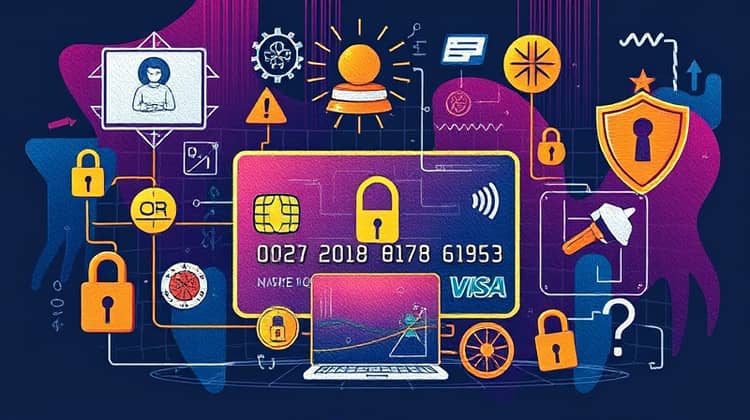Credit card fraud is one of the fastest-growing crimes that presents serious threats to consumers and businesses alike. Understanding how to protect yourself from this type of fraud is crucial in the modern digital age. In this article, we'll explore what credit card fraud is, how it happens, its types, and most importantly, how to safeguard your information online.
While credit card fraud can result in significant financial loss, it also causes emotional distress for victims who often feel violated and anxious about their security. By being aware of the tactics used by fraudsters and applying preventive measures, you can protect your financial well-being and maintain your peace of mind.
Understanding Credit Card Fraud

Credit card fraud involves the unauthorized use of someone else's credit card information to make purchases or access funds. This can happen through various methods, including theft, hacking, and online scams. With the increasing reliance on online transactions, the incidence of credit card fraud has dramatically risen, posing a challenge for consumers and banks alike.
Many credit card companies have ramped up their security measures in response to the growing trend of fraud; however, this is not foolproof. Understanding the fundamental aspects of credit card fraud is essential for individuals to protect themselves effectively. It is crucial to stay informed about the latest fraud tactics and what steps can be taken to minimize risks.
- Monitor your credit card statements regularly.
- Use strong and unique passwords for your online accounts.
- Be wary of unsolicited emails and texts asking for your information.
By taking these simple steps, you can significantly reduce the risk of becoming a victim of credit card fraud. Awareness and vigilance are your best defenses.
Common Types of Credit Card Fraud

Credit card fraud manifests in various forms, each with its own methods and characteristics. Understanding these different types can help individuals recognize potential threats more easily and take steps to protect themselves. The primary types of credit card fraud include card-not-present fraud, skimming, phishing, and identity theft, among others.
Credit card fraud can happen to anyone, regardless of security measures, but awareness of these common schemes can serve as an effective deterrent. Being informed allows consumers to remain vigilant and spot suspicious activity before it escalates.
Card-Not-Present Fraud
Card-not-present fraud typically occurs during online transactions where the physical card is not needed. This type of fraud exploits situations where a purchaser provides their credit card details over the internet without the need for a physical card, making it easier for fraudsters to carry out their schemes. This sudden rise in remote shopping has correlated with an increase in successful scams.
Fraudsters often obtain credit card details through various methods, such as data breaches, phishing scams, and malware. Once they have the card details, they can make unauthorized purchases from online vendors, leaving the cardholder to deal with the consequences.
The impact on cardholders can be severe, as disputes can take time to resolve, and the emotional toll of realizing that one's financial information has been compromised can be significant.
Skimming
Skimming is another common type of credit card fraud that involves the theft of credit or debit card information using a small device called a skimmer. This device can be attached to card readers at ATMs, gas stations, or stores, capturing card information during legitimate transactions without the cardholder's knowledge. Skimming is particularly insidious because it often goes unnoticed until fraudulent activity occurs on the victim's account.
Fraudsters target locations where people are often distracted or hurried, making it easy to install the skimming devices without drawing attention. Once they have obtained the card information, they can create counterfeit cards and use them for unauthorized purchases, leaving victims to sift through the aftermath of the crime.
Cardholders should take precautions such as inspecting card readers for any unusual attachments and using ATMs located inside trusted establishments to help reduce the risk of falling victim to skimming.
- Inspect card readers for unusual attachments.
- Use ATMs located inside banks or trusted establishments.
- Cover your PIN when entering it at the ATM.
Phishing
Phishing is a deceptive tactic employed by criminals to trick individuals into revealing sensitive information such as credit card numbers, passwords, and social security numbers. This is typically accomplished through fake emails, websites, or text messages that appear to be from legitimate sources such as banks or popular online retailers.
The goal of phishing is to create a sense of urgency, prompting victims to act quickly without thinking critically about the request. Once the fraudsters obtain the card details, they can exploit this information for financial gain, often with devastating effects on the victims' finances.
- Look for misspellings or unusual sender addresses in emails.
- Avoid clicking on links in unsolicited messages.
- Verify requests by contacting the organization directly.
Being cautious and scrutinizing communications can help protect against falling victim to phishing attempts. Empowering yourself with knowledge is key to safeguarding your personal information online.
Identity Theft
Identity theft occurs when someone illegally obtains and uses another person’s personal information—such as social security numbers, credit card details, and bank account information—to commit fraud or other crimes. This crime can have serious ramifications, with victims facing life-altering consequences that can take years to fully resolve. The lasting impact on the victim's credit report can hinder their ability to secure loans or financial products in the future.
Fraudsters may gather sensitive data through various tactics, including phishing, hacking, and social engineering techniques. Once they have enough personal information, they may open new accounts in the victims' names, make unauthorized purchases, or even engage in criminal activities using the victim's identity.
This situation is particularly distressing as victims often find themselves having to prove their innocence while dealing with the financial burden and emotional trauma caused by the intrusion into their lives. Victims of identity theft may face numerous challenges in rectifying their credit and finances, making it crucial to take preventive measures. Common preventative actions include using credit monitoring services and freezing credit reports whenever possible for added security.
To combat identity theft, consumers must stay informed and proactive about their personal security.
How Credit Card Fraud Impacts You

The impact of credit card fraud extends far beyond the immediate financial loss suffered by victims. The emotional toll can lead to anxiety, stress, and a feeling of violation, creating an atmosphere of uncertainty in one's personal and financial life.
Victims often report a loss of trust in online transactions and may become overly cautious, which can lead to a decrease in spending and an unwillingness to engage in necessary financial activities. Furthermore, the intricacies of resolving credit disputes and alerting banks can drain one's time and energy, diverting attention from daily life responsibilities and joys.
Lastly, credit card fraud can have ripple effects on the economy, leading businesses to incur losses, increase costs on security measures, and potentially pass down those expenses to consumers.
Tips to Protect Yourself Online

To safeguard yourself from credit card fraud in the digital world, it's essential to adopt safe online practices. Understanding that not all websites are secure and that some may be fronting as legitimate services is crucial for every online transaction. It is always advisable to use trusted and verified websites and to enable two-factor authentication wherever possible for added online security.
Regularly updating passwords, using strong passwords that are unique for different accounts, and avoiding public Wi-Fi for financial transactions can make a significant difference in avoiding fraud.
- Always use secure connections (look for HTTPS).
- Enable two-factor authentication on your accounts.
- Regularly monitor your financial statements for unauthorized transactions.
Taking proactive measures not only enhances your personal security but also promotes a safer online shopping environment for everyone.
What to Do If You’re a Victim

If you find yourself a victim of credit card fraud, it is vital to act quickly. Immediately contact your credit card issuer to report the fraudulent activity and freeze or cancel your card to prevent further unauthorized charges.
- Report the fraud to your credit card company.
- File a report with the Federal Trade Commission (FTC) or your country's equivalent.
- Monitor your accounts closely for any additional fraudulent activity.
Taking the right steps immediately after discovering fraud can help mitigate losses and restore a sense of security.
Credit Card Fraud Laws and Regulations

Various laws and regulations exist to protect consumers from credit card fraud and identity theft. In the United States, the Fair Credit Billing Act (FCBA) provides guidelines on disputing fraudulent charges, limiting a cardholder's liability to $50 for unauthorized use, provided the card is reported lost or stolen.
Moreover, stringent regulations are in place to compel financial institutions to maintain robust security measures and protect their clients. Laws like the Gramm-Leach-Bliley Act aim to prevent identity theft and establish privacy protection standards for financial institutions and businesses.
Credit card issuers are also subject to the Payment Card Industry Data Security Standards (PCI DSS), providing guidelines on how to use, store, and transmit credit card data securely, which helps keep consumers safe from fraud.
The Future of Credit Card Security

As technology continues to evolve, so too do the methods used by fraudsters. However, advancements in security technology aim to protect consumers better than ever before. Innovations such as biometric authentication, EMV chip technology, and blockchain are changing the landscape of credit card security significantly.
Furthermore, artificial intelligence and machine learning are being integrated into fraud detection systems, capable of identifying suspicious activities in real-time and alerting users immediately. Due to the dynamic nature of the digital world, remaining vigilant and updated on the latest security practices will be paramount.
As new threats arise, so too will the responses from industries and regulators to create a safer environment for online transactions.
Conclusion

Credit card fraud poses a significant risk to consumers in today's increasingly digital world. However, with proper knowledge, vigilance, and the implementation of protective measures, individuals can safeguard their financial information effectively.
By understanding the types of fraud, recognizing signals of suspicious activity, and knowing what steps to take if compromised, consumers can empower themselves in the battle against credit card fraud. Armed with this information, you can navigate the online marketplace with confidence and security.














